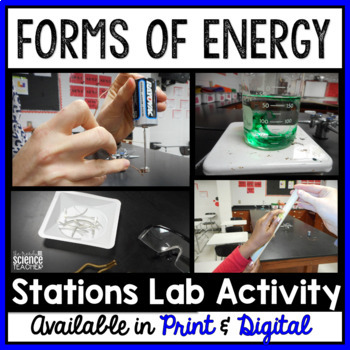Forms of Energy Stations Lab (Print & Digital for Distance Learning)
- Zip
- Internet Activities
What educators are saying
Description
Get your students up and moving with this HANDS-ON Forms of Energy Station Lab activity. This product is FULLY EDITABLE so that you can edit to fit the needs of your classroom and students.
Need a digital option for distance learning, a flipped classroom, or as an alternative to an in-person lab? No problem! I have included a DIGITAL option in this resource!
Students will practice identifying many different forms of energy and energy transformations such as:
✅kinetic and potential energy (mechanical energy)
✅chemical energy
✅light/radiant energy
✅thermal/heat energy
✅magnetism
✅electricity
✅electromagnetic energy
✅sound energy
✅nuclear energy
Included in this Resource:
⭐9 lab stations (Editable)
⭐Student Answer Document (Editable)
⭐Answer Key
⭐Blank Station Card (to add to your stations)
⭐Teacher Instructions, Suggestion and Set-Up Guide (with PHOTOS!)
⭐Digital version of lab *Please note: The digital version of the lab will include a link that will take you to a Google Slides document.
⭐⭐⭐Please see the preview for a list of materials needed for this lab.
You might also like these ENERGY resources:
✅ Energy Digital Scavenger Hunt Project
✅ Energy Review Student Led Stations
✅ Forms of Energy Doodle Notes (worksheet)
✅ Forms of Energy MAZE worksheet BUNDLE
✅ Forms of Energy Lesson Plan and Activity Bundle
✅ Forms of Energy Maze Worksheet
✅ Heat Energy Transfer: Ice Cream Lab
✅ Bundle & Save 20%►Energy Unit Bundle (Free Updates for Life)
Connect with me:
❤️Newsletter ❤️Blog ❤️Facebook ❤️Instagram ❤️Pinterest
TPT Customer Tips:
How to get TPT credit to use on future purchases:
*Please go to your My Purchases page (you may need to login). Beside each purchase you'll see a Provide Feedback button. Simply click it and you will be taken to a page where you can give a quick rating and leave a short comment for the product. Each time you give feedback, TPT gives you feedback credits that you use to lower the cost of your future purchases. Feedback and ratings are most greatly appreciated.
Be the first to know about my sales, discounts, freebies and new products:
*Look for the green star next to my store logo (THE TRENDY SCIENCE TEACHER) and click it to become a follower. That's it! You will now receive email updates about this store.





